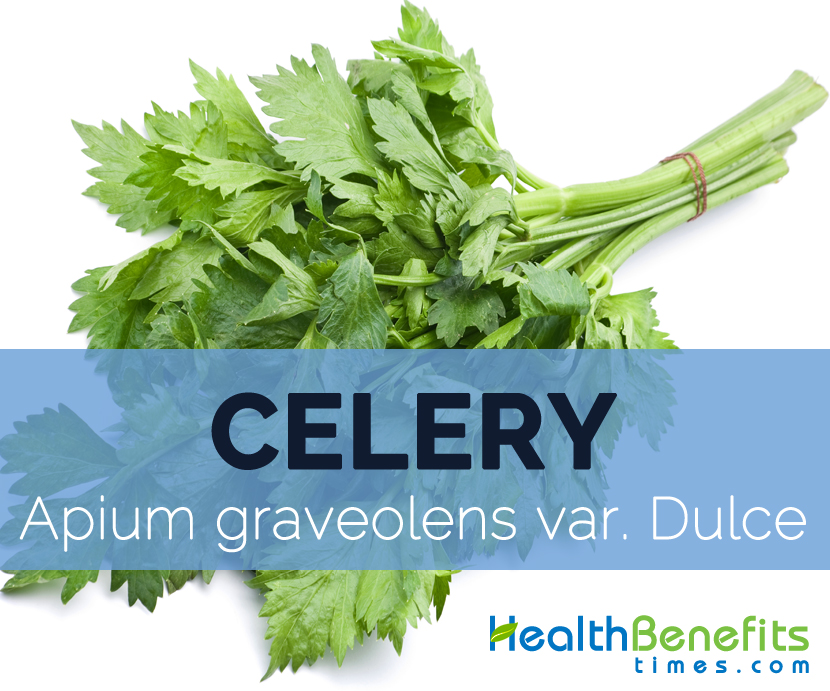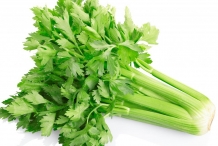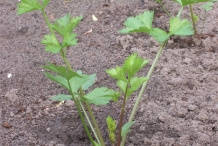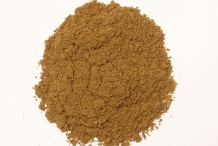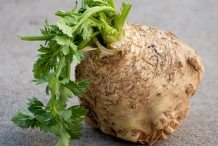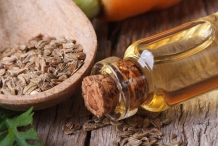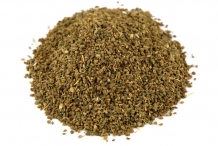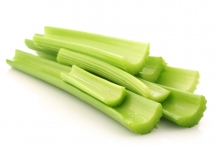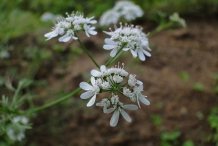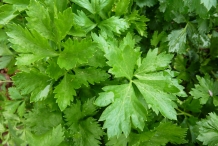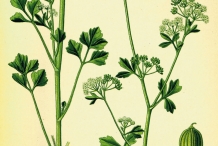| Celery Quick Facts |
| Name: |
Celery |
| Scientific Name: |
Apium graveolens var. Dulce |
| Origin |
Temperate Mediterranean climates in Europe, Africa and Asia. But now commonly cultivated in Europe, Central and North America, Japan, North Africa, China and India. |
| Colors |
Gray or brownish |
| Shapes |
Round, small; Diameter: 1.5-2 mm |
| Calories |
16 Kcal./cup |
| Major nutrients |
Vitamin K (24.67%)
Vitamin B9 (9.00%)
Vitamin B6 (5.77%)
Potassium (5.60%)
Sodium (5.40%)
|
| Health benefits |
Forbid cance, Assist asthm, Diuretic action, Migraine headaches, Diabetes health |
Celery or stalk celery (Apium graveolens var. Dulce) is a species of Apium graveolens L. in the family Apiaceae, native to the temperate Mediterranean climates (Europe, Africa and Asia), and widely cultivated as spice, herb and vegetable in Europe, Central and North America, Japan, North Africa, China and India.
It is a biennial plant which is usually cultivated as an annual plant. It forms a bipinnate leaves 3–6 cm (1.2–2.4 in) long with numerous leaflets. There are three types of Celery such as leaf celery, pascal celery and celeriac celery. It is consumed either raw or cooked as a vegetable.
Plant
Celery is a light to dark green, biennial or perennial plant in the temperate climates. The plant grows upto 1 meter high. It forms a light to dark green, pinnate-bipinnate leaves; 3–6 cm (1.2–2.4 in) long and 2–4 cm broad. It grows an erect, grooved and silnovetvisty stem with 2-3 mm diameter creamy to white flowers. The seeds are ovoid to globose; 1.5–2 mm long and wide. Celery grows best in well-drained soil. The plant normally lives upto two years.
Nutritional Value
The nutrients found in Celery include Vitamin B1, B2, B3, B5, B6, B9, folate, choline and Vitamin C. Celery is also a very good source of minerals such as Calcium, Magnesium, Phosphorus, Potassium, Sodium and Fluoride. 101 g of celery possess 11 mg of magnesium, 263 mg of potassium, 0.104 mg of manganese, 40 mg calcium, 0.13 mg zinc, 0.2 mg iron, 24 mg phosphorus and 81 mg sodium.
Health Benefits of Celery
Celery is loaded with antioxidants, minerals and vitamins such as Vitamin C, Vitamin K, folate, potassium and Vitamin B6. It also possess anti-inflammatory properties that enhance the blood pressure, cholesterol levels and prevents the heart disease. The huge presence of water prevents from dehydration. It also enhances the skin, liver, cognitive health.
- Lower blood pressure
Celery possess an organic chemical compounds such as pthalides that helps to reduce the stress hormones in the blood. It allows the expansion of blood vessels providing the more space to move which helps to reduce pressure. It lowers the stress on the cardiovascular system that reduces the chances of stroke, heart disease and atherosclerosis. (1)
- Lowers cholesterol
The daily intake of Celery helps to lower the bad cholesterol. The presence of pthalides enhance the secretion of bile juices that assist to lower the cholesterol levels. It generally improves the heart health. The fiber eliminates the cholesterol from the body in the form of bowels. (2)
- Antiseptic action
Celery seeds possess the diuretic properties that help to enhance urination and eradicate uric acid. Celery assists the kidney problems, bladder disorders and cystitis. It also prevents the infection on the urinary tract.
- Eliminates joint problems
It helps the people with rheumatism, arthritis and gout. It possesses anti-inflammatory properties that lower the pain and swelling around the joints. It eliminates the uric acid crystals that lead to the discomfort in the use of joint. It increases the regrowth tissue in inflamed joints. (3)
- Forbid cancer
Celery possesses the cancer counteracting components such as flavonoids, phthalides and polyacetylenes that eliminate carcinogens. It possesses coumarins which promote the activity of white blood cells that helps to prohibit cancer. The antioxidant components eliminate the free radicals from the body that results to the cancer. (4)
- Enhance immunity power
As Celery possesses an excellent source of Vitamin C, it enhances the immune system. The regular consumption of Vitamin C helps to lower the chances of common cold and also prevents from various diseases. (5)
- Assist asthma
Vitamin C prevents the damage caused by free radicals. Celery also possesses anti-inflammatory properties that lower the inflammatory conditions such as asthma. (6)
- Improves cardiovascular health
The rich amount of fiber, Vitamin C and organic chemicals found in the roots of celery enhance the cardiovascular health.
- Diuretic action
Celery possesses potassium and sodium in adequate amount which helps to balance the fluid in the body. Potassium functions as a vasodilator and also lowers the blood pressure. (7)
- Migraine headaches
Coumarins assist to provide relief from the pain of migraine headaches. The research shows that migraine is caused due to the suppression of Nitric Oxide release in the brain. (8)
- Diabetes health
As Celery leaves are rich in fiber, the consumption of Celery leaves helps to treat the diabetic conditions as well as manages the diabetic symptoms effectively. (9)
https://www.youtube.com/watch?v=HUMMByHm0F4
Traditional uses
- Celery is used in traditional Oriental medicine in order to treat hypertension as it possess phthalide compounds that acts as a sedative and also reduces blood pressure.
- The Celery extract is helps to clear the toxins from the system.
- Massage with the mixture of Celery extract, almond or sunflower oil helps to get relieve from the paingul gout in the toes or feet and arthritic joints.
- A tincture is used as a diuretic to treat urinary disorders and hypertension.
- The roots, aerial parts and fruits of Celery are used to treat agitation, mild anxiety, and loss of appetite, cough, fatigue and vermifuge.
- The leaves of celery are used in folk medicine to treat rheumatism and gout.
- Celery is used in the folk medicine to cure kidney disease, rheumatism and stone formation.
- In ancient times, it was used to treat the health ailments such as colds, digestion, flu and water retention.
- It is believed that the consumption of Celery can treat high blood pressure.
Precautions
- Celery may lead to the allergic reactions which may lead to fatal anaphylactic shock.
- Celery also increases the bleeding when it is used in medicinal amounts. So one with bleeding disorder should not use celery.
- Those with the kidney ailments should avoid the celery because it might cause an inflammation.
- People with low blood pressure should avoid the use of Celery.
- Pregnant women should avoid the celery seed as it may cause uterine bleeding, muscle contractions in the uterus that may cause miscarriage.
- Those allergic to birch pollen may experience allergic reactions to the celery seed.
Other Facts
- The bunch of celery consists of 10-12 individual pale green stalks.
- Head of celery possess stalks and leaves.
- Due to high amount of Vitamin K, C, B2, dietary fiber and low amount of calories, it is effective for using as a diet.
- All parts of celery are consumed.
- Chewing gently the stalks of Celery after the meal helps to clean the mouth and teeth.
Celery – Apium graveolens var. Dulce Facts
Celery belongs to the family Apiaceae and is close relative of carrot, parsnip and parsley. The plant of Celery can reach up to the height of 16 inches. Though it is a biennial plant, it is grown as an annual plant unless it is cultivated for seed. It provides low amount of calories. Celery if added to a diet provides numerous health benefits.
| Name |
Celery |
| Scientific Name |
Apium graveolens var. Dulce |
| Native |
Temperate Mediterranean climates in Europe, Africa and Asia. But now commonly cultivated in Europe, Central and North America, Japan, North Africa, China and India. Probably, Celery was cultivated 3000 years ago in the Mediterranean region. |
| Common/English Name |
Celery, stalk celery, leaf celery, turnip-rooted celery, celeriac |
| Name in Other Languages |
Albanian: selino
Basque: apioa
Bosnian: celer
Catalan: api
Croatian: celer
Czech: celer
Danish: selleri
Dutch: selderij
Estonian: seller
Finnish: selleri
French: céleri
Galician: apio
German: Sellerie
Hungarian: zeller
Icelandic: sellerí
Irish: soilire
Italian: sedano
Latvian: selerija
Lithuanian: salierai
Maltese: karfus
Norwegian: selleri
Polish: seler
Portuguese: aipo
Romanian: țelină
Slovak: zeler
Slovenian: zelena
Spanish: Apio
Swedish: selleri
Welsh: seleri
Azerbaijani: kərəviz
Lao: celery
Turkish: kereviz
Afrikaans: seldery
Chichewa: selari
Hausa: seleri
Igbo: celery
Sesotho: seleri
Somali: celery
Swahili: celery
Yoruba: seleri
Zulu: isilimo esidliwayo esinamagatsha anamanzi
Cebuano: celery
Filipino: kintsay
Indonesian: seledri
Javanese: celery
Malagasy: seleria
Malay: saderi
Maori: herewi
Esperanto: celerio
Haitian Creole: seleri
Latin: apium |
| Plant Growth Habit |
Biennial or perennial herb |
| Growing Climate |
Temperate |
| Soil |
Well-drained |
| Plant Size |
1 meter |
| Lifespan |
Two years |
| Stem |
Erect, grooved, silnovetvisty |
| Leaf shape and size |
Pinnate – bipinnate; Length: 3–6 cm (1.2–2.4 in); Breadth: 2–4 cm |
| Leaf color |
Light to dark green |
| Flower |
Creamy-white; Diameter: 2–3 mm |
| Seed shape & size |
Ovoid – globose; Length and Width: 1.5–2 mm |
| Seed weight |
1 ounce- 72,000 seeds
1 gram- 2500 seeds |
| Fruit shape and size |
Round, small; Diameter: 1.5-2 mm |
| Fruit color |
Gray or brownish |
| Flavor/aroma |
Strong aromatic |
| Varieties/Types |
- Leaf celery
- Pascal celery
- Celeriac celery
|
| Major Nutritions |
Vitamin K (phylloquinone) 29.6 µg (24.67%)
Vitamin B9 (Folate) 36 µg (9.00%)
Vitamin B6 (Pyridoxine) 0.075 mg (5.77%)
Potassium, K 263 mg (5.60%)
Sodium, Na 81 mg (5.40%)
Vitamin B5 (Pantothenic acid) 0.248 mg (4.96%)
Manganese, Mn 0.104 mg (4.52%)
Vitamin B2 (Riboflavin) 0.058 mg (4.46%)
Total dietary Fiber 1.6 g (4.21%)
Calcium, Ca 40 mg (4.00%) |
| Health Benefits |
- Lower blood pressure
- Lowers cholesterol
- Antiseptic action
- Eliminates joint problems
- Forbid cancer
- Enhance immunity power
- Assist asthma
- Improves cardiovascular health
- Diuretic action
- Migraine headaches
- Diabetes health
|
| Calories in 1cup (101 gm) |
16 Kcal. |
| How to Eat |
- It is used to add a flavor in salads, stews and soups.
- The chopped stalks of Celery are cooked as a vegetable.
|
Comments
comments


